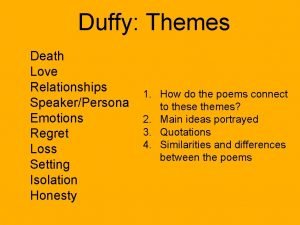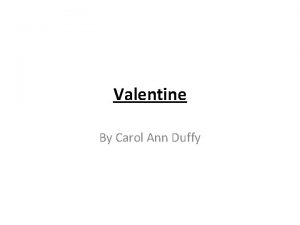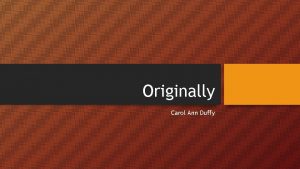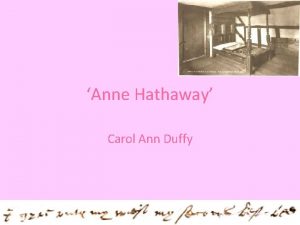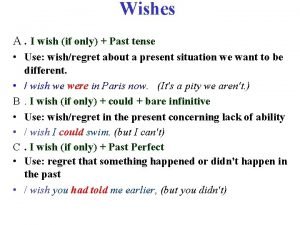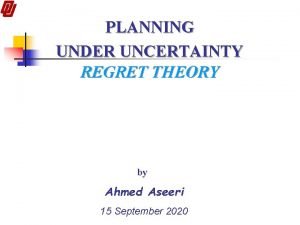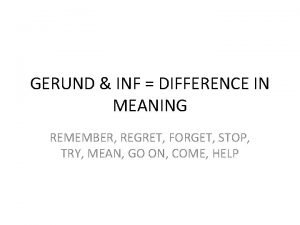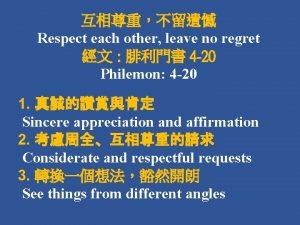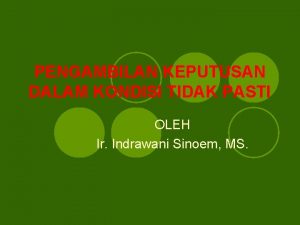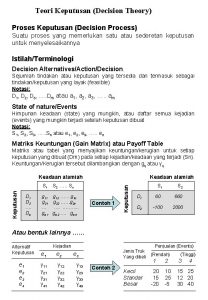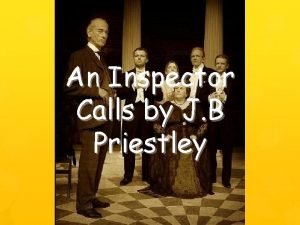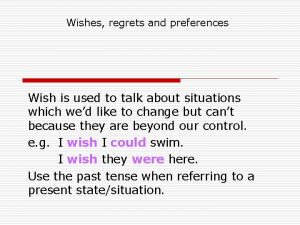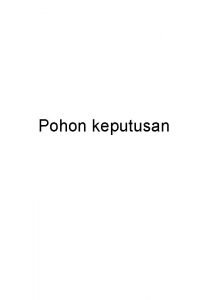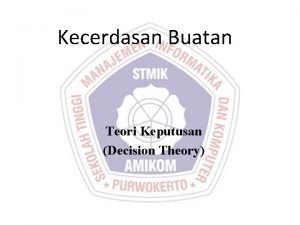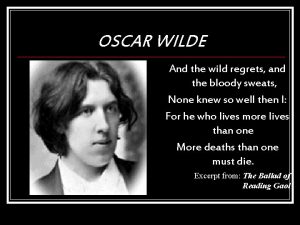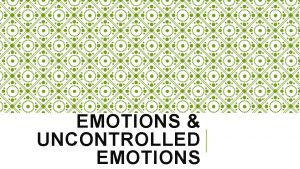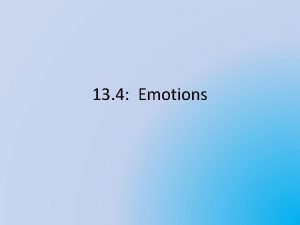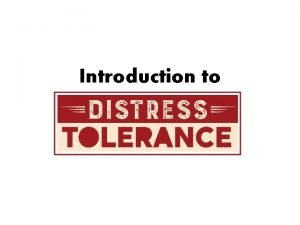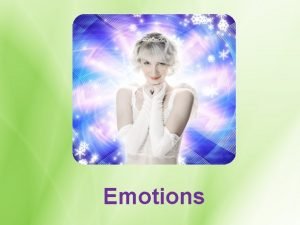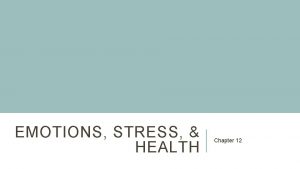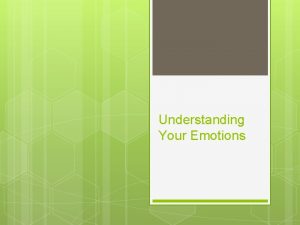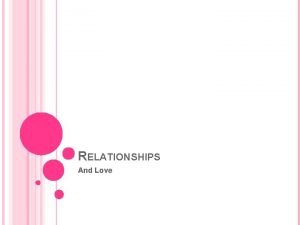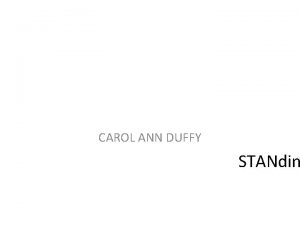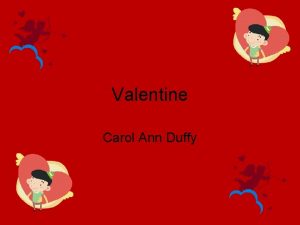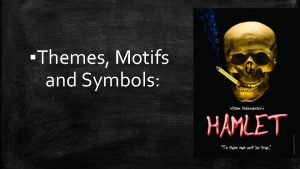Duffy Themes Death Love Relationships SpeakerPersona Emotions Regret





















- Slides: 21

Duffy: Themes Death Love Relationships Speaker/Persona Emotions Regret Loss Setting Isolation Honesty 1. How do the poems connect to these themes? 2. Main ideas portrayed 3. Quotations 4. Similarities and differences between the poems

Question 1 • 2 quotations that show his mood E. g. “finally alone” or “spools of suffering” or “All flesh is grass” • Explain what techniques are used in your quotation and what it tells us about his mood Example Answer “finally alone” this example of word choice creates emphasis on the word “alone”. This highlights his solitude and how he is isolated due to his experiences. Therefore Duffy illustrates the photographer is presented in a solemn mood as he is forced to confront his emotions without assistance.

Mark scheme • Pupils must identify the mood, then provide textual reference and then comment fully (maximum of 2 marks). • Sinister mood - “spools of suffering” - alliteration of “s” sound/the idea of a great many gruesome images might at first lead the reader to feel that the man in the poem is sinister/cruel/evil or “ordered rows” – the methodical way he works/the suggestion of war graves might at first lead the reader to feel that the man in the poem is sinister/cruel/evil • Sombre/Solemn/Depressing mood – phrases like “finally alone”, the comparison of the man to a priest leading a mass ( for many deaths) creates a serious , solemn mood.

Question 2 • 2 quotations that show his mood E. g. “tremble” or “fields which don’t explode beneath the feet” or “children running in a nightmare heat” • Explain what techniques are used in your quotation and how it shows he is feeling disturbed Example Answer “solutions slop in trays” – the alliteration of “s” suggests instability and causes the reader to focus on the idea that he is clumsily slopping the solution into the processing tray, perhaps his shaking hands as he processes his images. Therefore he is clearly disturbed and is nervous and reluctant to relive the sights he saw at war.

Mark scheme • “solutions slop in trays” – alliteration suggests instability, perhaps his shaking hands as he processes his images. • “tremble” – while he must have a controlled, calm detached attitude to take his pictures, the emotional content now disturbs him as he remembers and relives what he has witnessed. • Contrast: “Rural England” and war torn places he visits - “fields that don’t explode beneath the feet of running children”. This creates a sense that he cannot escape the emotional impact of the human suffering he witnesses, even when he is safe in his own house, hos own country. • “nightmare heat” suggests it is a horror and an inescapable experience of pain and suffering that burns through his mind as the chemicals burnt through the bodies of the people attacked in war zones. • Enjambment – suggests loss of control, disorder, being emotionally affected as he processes the images

Question 3 • 2 quotations that show the emotional impact E. g. “half formed ghost” or “A stranger’s features faintly start to twist” or “blood stained into foreign dust” • Explain what techniques are used in your quotation and how it shows the emotional impact Example Answer “twist” – the word choice suggests not only the grimace of pain on the face of the man in the photo, but the guilt and pain of the photographer at taking the picture and invading the moment of this man’s suffering and death. Therefore showing that long after the experience itself the feelings of guilt and remorse will remain.

Mark scheme • “twist” – suggests not only the grimace on the face of the man in the photo, but the guilt and pain of the photographer at taking the picture and invading the moment of this man’s suffering and death. • “half formed ghost” – not just the photographic negative, but also the idea that the photographer feels haunted by his work, feels guilty, feels morally implicated, feels judged. • “remembers the cries of this man’s wife” – implies that he is unsure that he had permission to take this picture/fears that his wife might have hated him for taking the picture. • “How he sought approval” points to the ethical dilemma of war photography – what right does he have to take this picture/ who gave him permission? No-one. • “what someone must” – the photographer is in a dilemma: if he takes the pic, he may be offending the dignity of the man and his family; yet if he does not, no one will know about, or be able to do anything about, human suffering in foreign lands.

Question 4 • 2 quotations that show the contrast between the photographer and the editor • 2 quotations that show the contrast between the photographer and the public E. g. “a hundred agonies in black and white” or “pick out five or six” or “reader’s eyeballs prick with tears” or “stares impassively” • Explain what techniques are used in your quotation and how it shows the difference between the photographer and the editor/public Example Answer “a hundred agonies in black and white” illustrates the importance of the photographs to the photographer and he views the “agonies” and is highly distressed by the suffering whereas the editor will “pick out five or six” therefore showing that they are removed from the content and sees them merely as content for the magazine not real scenarios.

Mark scheme • While the photographer goes through emotional torment and great personal risk to take his pictures so that we in Britain know about it, the editor will select only those that he thinks are suitable for his newspaper – “pick out five or six” and then publish them in the Sunday magazine, reducing their impact and changing their meaning/truth. • We, the reading public, are also criticized, as we look at the pictures while we are relaxing at home, and while we may be briefly concerned, we quickly forget the suffering of those in foreign lands and return to our safe lives. This is emphasized by Duffy’s pithy use of rhyme and rhythm in the line “The reader’s eyeballs prick with tears between the bath and pre-lunch beers”

Scottish Texts: The 10 Mark Question

How to answer the Q… • All Questions are worth 10 marks and should be structured using bullet points and headings. • Use the headings: • Commonality (2 marks) • Primary Text (2 marks) • Secondary Text(s) (6 marks)

(1) Commonality Use a paragraph to explain what the commonality is between the primary and secondary texts. Try to give details. E. g. Identification of theme (1) Some comment/explanation (1) OR E. g A way in which the characters/personas are similar/different (1) Some comment/explanation (1)

(2) Primary Text Analyse a relevant example from your primary text/exam poem. E. g. Reference to text/quote (1) + comment (1)

(3) Secondary Text Focus on one or two other poems. Analyse three relevant quotations from your second/third poem. Always link back to the question at the end of each bullet point. E. g. Reference to text/quote (1) + comment (1) (x 3)

Practice Question Text: “War photographer” • Discuss how Carol Ann Duffy uses the language in War Photographerand at least one other poem to highlight the poem’s central concerns. (10 marks)

Example Answer: Commonality * In “War photographer”, the central concern is the negative impact of war and how the horrors that the photographer has experienced have changed him for good. However, he is dismayed that others do not have the same reaction or show compassion to the victims. Duffy uses graphic descriptions to fully convey the horrors of war and utilises comparisons both religious and otherwise to show the photographer stands alone in his views. * In “Valentine”, the central concern is that the speaker is rejecting the traditional interpretation of love and opting for a more realistic view which acknowledges the harsh realities of romance. Duffy illustrates this view clearly through the unconventional structure of the poem and the language used, especially the repetition of words such as “No” and “Not. ”

Primary Text * “Solutions slop in trays beneath his hands, which did not tremble then though seem to now. ” * *We see the clear contrast to this strong facade illustrated during his work abroad when the alliteration draws our attention to his weakness while developing pictures. Clearly, the horror of what he has witnessed affects his mentality. The word choice of “tremble” suggests that he is visibly shaking as the horrors of his experience continue to reverberate through his consciousness and remind him of what he witnessed. After holding it together for so long, he allows himself to have a moment of weakness when reflecting. *Duffy use the photographer to explore theme of apathy as he feels the need to do this job to inform people of the horrors others are experiencing while we enjoy the comforts of our home.

* ”Not Secondary Text a red rose or a stain heart” This dismissive word choice of “Not” immediately provides a contrast to the expectations created by the title. The speaker rejections the stereotypical gifts of “a red rose or a satin heart” which suggest romance and love, therefore initially appearing to indicate that this poem will not be romantic. However, it sets the tone to illustrate that while the speaker rejects traditional gifts it is due to the fact they are searching for a truer love. * “It will blind you with tears like a lover” * This simile compares love and relationships to the scent of an onion to acknowledge that love cannot be perfect and that pain must be expected. Just as the scent of an onion will draw tears from your eyes so to can a person that you love create intense feelings of upset as love is likely to end. Therefore Duffy forces the speaker to accept the truth about love and acknowledge the pros and cons. “Lethal. It’s scent will cling to your fingers cling to your knife” * The short sentence of “knife” creates a harsh tone and indicates a threat and severe consequences that can be expected from love and marriage. The word choice of “Lethal” suggests danger and destruction and illustrates that the speaker believes that relationships will end eventually and this can be destructive for the life of an individual but that marriage can also be destructive for a relationship as it can be too restrictive. The extended metaphor also continues in this phrase as the scent of the onion represents the feelings of love that will remain and cling to your memories even after the end of a relationship which can be easily destroyed. Just as a knife can cut an onion so to can humanity and their flaws destroy a relationship. * * Duffy uses a range of language techniques to illustrate the speaker rejecting traditions and trying to portray an honest and truthful representation of love.

Try this! • Now use the example answer and structure in these notes to answer the “War Photographer” 10 mark question that we started to look at yesterday.

Questions 1. Referring closely to lines 1 -2, identify the tone of the poem 2. Referring to poetic technique, show contrast is used in lines 2 -10 to help develop the speaker’s ideas 4 3. Show any example of the poet’s use of language in lines 11 -17 effectively contributes to the main ideas or concerns of the poem. 2 4. How effective do you find any aspect of the final stanza as a conclusion to the poem? Your answer might deal with ideas and/or language. 2 5. With close textual reference, show the ideas and/or language of this poem are similar OR different to another poem or poems by Carol Ann Duffy which you have read. 10 6. Marks 2 20

Other practice questions 1. By referring to “Havisham” and to at least one other poem by Carol Ann Duffy, discuss her ability to surprise the reader with unexpected ideas and/or unexpected language. 2. Discuss how Carol Ann Duffy uses the closing lines in Mrs Midas and at least one other poem to highlight the poem’s central concerns. 3. Discuss how effectively Carol Ann Duffy explores theme of love in Valentine and at least one other poem. 4. Discuss how theme of loss is explored by Carol Ann Duffy in the poem Mrs Midas and at least one other. 5. By referring to “War Photographer” and at least one other poem, discuss how Carol Ann Duffy conveys the feeling of isolation.
 Themes about regret
Themes about regret Love love jesus is love god greatest gift lyrics
Love love jesus is love god greatest gift lyrics Structure of valentine by carol ann duffy
Structure of valentine by carol ann duffy Originally carol ann duffy poem
Originally carol ann duffy poem Anne hathaway (poem)
Anne hathaway (poem) Shooting stars poem carol ann duffy
Shooting stars poem carol ann duffy If only wishes
If only wishes Minimax regret method
Minimax regret method Regret analysis
Regret analysis Online learning regret
Online learning regret Meaning
Meaning Leave no regret
Leave no regret Kriteria regret adalah
Kriteria regret adalah Kriteria realisme
Kriteria realisme Love fiilinin 3. hali
Love fiilinin 3. hali Contoh soal minimax regret
Contoh soal minimax regret Site:slidetodoc.com
Site:slidetodoc.com Wishes regrets
Wishes regrets Pohon keputusan adalah
Pohon keputusan adalah Pohon keputusan kecerdasan buatan
Pohon keputusan kecerdasan buatan Oscar wilde biography
Oscar wilde biography Write a paragraph about what you regret and why
Write a paragraph about what you regret and why
